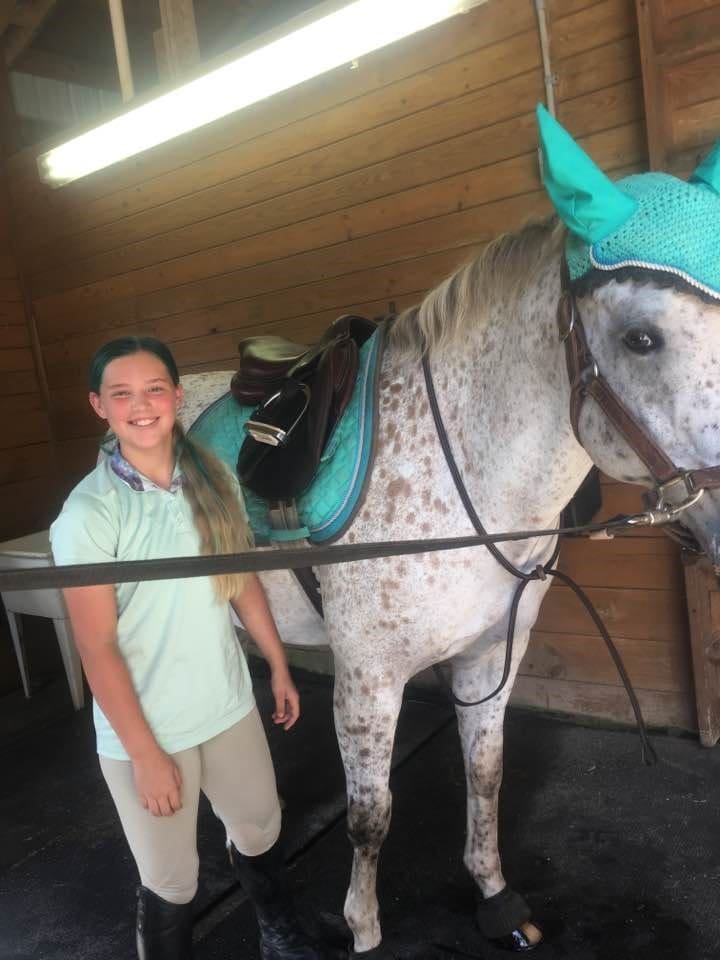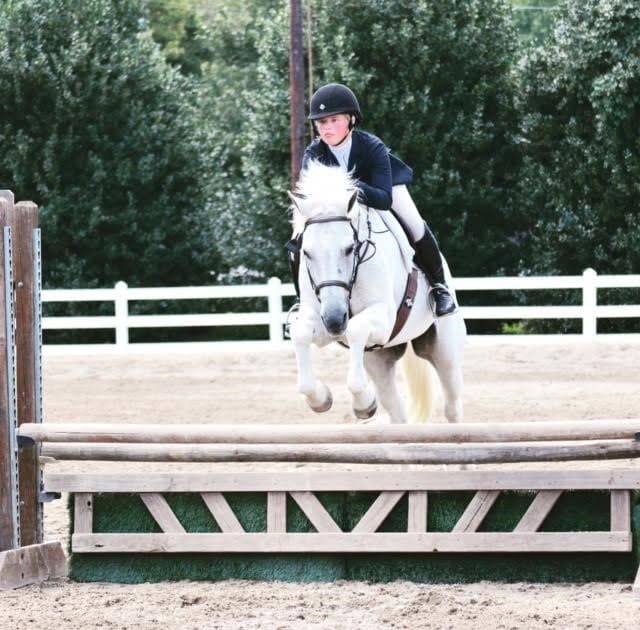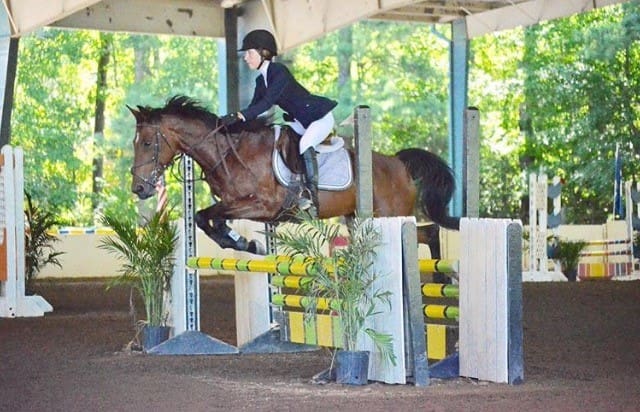MARIETTA, Ga. — Mya Borysiak waits patiently aback her horse, Cosmo, on the sidelines of the Hunter Jumper ring at Will’s Park Equestrian Center waiting for her name to be called. Her heart is beating fast, but not as fast as Cosmo’s. She can feel his muscles flex as he shifts his weight back and forth excitedly, preparing for his run. Even though she is expecting it, hearing her name announced over the loudspeakers still makes her jump a little. And with that, she’s off.
Spectators sit and stand all around the ring. She recognizes competitors and trainers from other barns. It is important now to tune all those distractions out of her mind and focus on the task straight in front of her.
The first jump is just ahead. She can hear her trainer’s voice in her mind, “Use your legs!” “Soft hands on the reigns!” “Keep his arch round!” “You can do this Mya.” “Count his paces…now…jump!” “This is what you’ve been training for.”
A Sport Unlike Any Other
For some, English style horseback riding has always been a sport that carried with it the stereotype of being for the elite. The mere term “equestrian” conjures up an image of stuffy looking young women in blue blazers and khaki pants astride their pristinely manicured horses.
But as the popularity of English riding spreads through Marietta, a light is shown on the reality of what is behind those stable doors— a challenging and rewarding youth sport that centers on hard work, sacrifice, and commitment.
Mya, 12, and Anna, 13, Borysiak are middle school students at Hightower Trail Middle School in Marietta. They have been riding for over six years.
“This sport is a lot more intense than people think,” Mya said. “If you really want to be good you have to train every day of the week. You normally ride for an hour or a little more. It’s the most dangerous sport in the world.”

Mya Borysiak, 12, stands beside her horse, Cosmo, in the wash rack after he was just saddled at Meadowview Stables in Marietta, Georgia — Photo by Jessica Cornwall
The Borysiak sisters ride at Shamrock Manor Equestrian Club in Marietta. There they train year- round with two different trainers: owner Megan O’Dwyer Thiel and riding school instructor, Bailey Columbe Elliott.
“I want to keep moving up. Right now I am doing local shows,” Mya said. “I ride in the ‘11 and under division’ competing in the ‘schooling hunter’ section. But I ride with Shamrock so we are constantly moving up. That’s the beauty of it. Some barns will put you in a division, and if you are placing well in it then they just kind of keep you there. You have to be challenged or else you aren’t going to get better.”
Middle school is a hard time without the added stress of a highly demanding sport, but, for youth equestrians that are serious about their goals, living with very little free time and getting very little sleep comes with the territory.
“It takes up all of your free time too,” Mya said. “After school I come home, I’m at the barn for two or three hours and then you have maybe an hour or something to do homework. You are doing homework with it dark outside. It takes up all your time. If you really want to be a serious equestrian, you can’t do any other sports because it just won’t happen. It’s a lot of commitment. You have to be really serious about it.”

Mya Borysiak, 12, competes on her horse, Mojo, at a horseback riding competition at Will’s Park in Alpharetta, Georgia — Photo by Nora Ewing
Riders can be expected to train for and compete in different shows throughout the year. As the riders move up in skill, they gain access to different shows. Some of those shows require trying out within the barn and getting selected to represent the barn in larger competitions. The Interscholastic Equestrian Association (IEA) hosts shows that promote competition between barns.
“Each barn puts together their own IEA team, there are tryouts,” Mya says. “Once you are on the team you have all these IEA practices, and you ride your barn’s horses. At the show, the trainers have a group meeting and draw out a horse’s name and a rider’s name. Each rider gets another barn’s horse to compete on. It’s really competitive and at the end of the season the best barn wins.”
Knowing how to take criticism and learn from it is an important aspect of competing. Trainers are here to teach students and help them reach their goals. They are not here to coddle them. After all, they will ultimately be representing the barn in front of other riders, trainers, and judges. The young riders learn fast that this is a sport. The horses you ride are your teammates, not your pets. If you want to move up in skill and rank, then you will have to become accustomed to growing out of horses and moving on to a better fit.
Getting Ready to Ride
Riding at Shamrock Manor is a lot more than showing up and hopping on a horse. The riders are taught animal husbandry and equine care. They are each expected to groom and prepare their horses before their rides. After riding, they are expected to bathe their horses and tuck them away clean and dry in their stable or field to rest.

Mya Borysiak, 12, uses a curry comb on her horse, Cosmo, at the beginning of his grooming session before her practice ride at Meadowview Stables in Marietta, Georgia. —
Photo by Jessica Cornwall
“I think it’s really important that people know how to care for their horse,” Mya said. “Some barns have grooms that always have the horses ready for once the kids get there but that’s really bad. The kids never really know how to care for horses or how to tack them up properly.”
Grooming and being involved with the animal’s care helps the riders bond with their horses and, more importantly, the horses bond with their riders.
According to a study published in the Journal of Neurosurgery, horse riding is the leading cause of traumatic brain injuries of any sport. No matter how strong the rider, ultimately their safety is being placed in the hands, or rather, hooves, of the horse they ride.
“It is important to have a bond with the horse,” Mya said. “Not only do you and the horse have to have the same athletic ability, but you also have to get along with the horse. Sometimes a horse and a rider just don’t fit. If they don’t like each other that can cause confusion and anger, and the ride won’t go well. It’s all about communication when you are riding a horse.”
Part of bonding with a horse is learning its abilities and how those abilities relate to your own. Anna Borysiak has leased four horses is the last six years of riding, all with different strengths, weaknesses, and temperaments.
“The horse I ride now, Maggie, some of her strengths are speed and height,” Anna said. “She can go really fast without having to be pushed. She can jump very high for her height. Other horses that I’ve been on its harder to get them to move forward, where for her, it’s harder to get her to slow down.”
At the Shows
Competing in an English style horseback riding competition is an all-day affair. The shows run all summer and all winter. The riders, trainers and horses are often battling harsh weather conditions.
“In a soccer game the game will last maybe an hour or two hours at least,” Mya said. “Horse shows last three days.”
Even getting to the venue can be a journey. The horses must be ferried out to the show in horse trailers. For Cobb riders, that can mean quite a drive. A drive that becomes harder after a long day at the park knowing that you will be up before the sun to begin again.
“Here in Marietta the most common equestrian park for horse competitions is Will’s Park in Alpharetta,” Mya said. “So, depending on where you live it can be 30 minutes or more away. With some horse shows, you’d have to go get a hotel room.”
Preparing for the shows starts weeks before the actual event. The riders and trainers work together to analyze any weakness the rider may have that could damage the overall score of the team. The riders practice riding new courses at their trainer’s instruction as they will have very little time to practice and learn a course once they get to the show.
“For jumpers you’ll read your course, learn your course, and then walk your course with your trainer,” Anna said. “They will give you tips like ‘take an inside turn here’ or ‘with your specific horse don’t do this or that’ so you can get the best ride that you can.”
Though the riders at Shamrock ride as a team, they are each expected to pull their own weight. Each rider is judged individually and is expected to have put in the hours of training in the weeks before the show.
“When you are on a horse team, it’s still you’re riding individually for your team,” Anna said. “It’s kind of all on you. So, instead of a coach saying something to the whole team, your trainer is directing everything at each person individually, about what they need to do to benefit the team. It’s a different feel because everyone is on different levels but still competing for the same team.”

Anna Borysiak, 13, holds her ribbons after a horseback riding competition at Will’s Park Equestrian Center in Alpharetta, Georgia. –Photo by Tara Borysiak
For more information about English style riding in Cobb County, to figure out show dates, or consider joining the team— Shamrock Manor Equestrian Club can be reached on Facebook at https://www.facebook.com/ShamrockManorEquestrian/.
At the Shows
Anna Borysiak, 13, competes in the hunter jumper category at a show at Will’s Park Equestrian Center in Alpharetta, Georgia. (Photo by Tara Borysiak)
Competing in an English style horseback riding competition is an all-day affair. The shows run all summer and all winter. The riders, trainers and horses are often battling harsh weather conditions.
“In a soccer game the game will last maybe an hour or two hours at least,” Mya said. “Horse shows last three days.”
Even getting to the venue can be a journey. The horses must be ferried out to the show in horse trailers. For Cobb riders, that can mean quite a drive. A drive that becomes harder after a long day at the park knowing that you will be up before the sun to begin again.
“Here in Marietta the most common equestrian park for horse competitions is Will’s Park in Alpharetta,” Mya said. “So, depending on where you live it can be 30 minutes or more away. With some horse shows, you’d have to go get a hotel room.”
Preparing for the shows starts weeks before the actual event. The riders and trainers work together to analyze any weakness the rider may have that could damage the overall score of the team. The riders practice riding new courses at their trainer’s instruction as they will have very little time to practice and learn a course once they get to the show.
“For jumpers you’ll read your course, learn your course, and then walk your course with your trainer,” Anna said. “They will give you tips like ‘take an inside turn here’ or ‘with your specific horse don’t do this or that’ so you can get the best ride that you can.”
Mya Borysiak, 12, competes on her horse, Mojo, at a horseback riding competition at Will’s Park in Alpharetta, Georgia. (Photo by Nora Ewing)
Though the riders at Shamrock ride as a team, they are each expected to pull their own weight. Each rider is judged individually and is expected to have put in the hours of training in the weeks before the show.
“When you are on a horse team, it’s still you’re riding individually for your team,” Anna said. “It’s kind of all on you. So, instead of a coach saying something to the whole team, your trainer is directing everything at each person individually, about what they need to do to benefit the team. It’s a different feel because everyone is on different levels but still competing for the same team.”
Anna Borysiak, 13, holds her ribbons after a horseback riding competition at Will’s Park Equestrian Center in Alpharetta, Georgia. (Photo by Tara Borysiak)
For more information about English style riding in Cobb County, to figure out show dates, or consider joining the team— Shamrock Manor Equestrian Club can be reached on Facebook at https://www.facebook.com/ShamrockManorEquestrian/.
